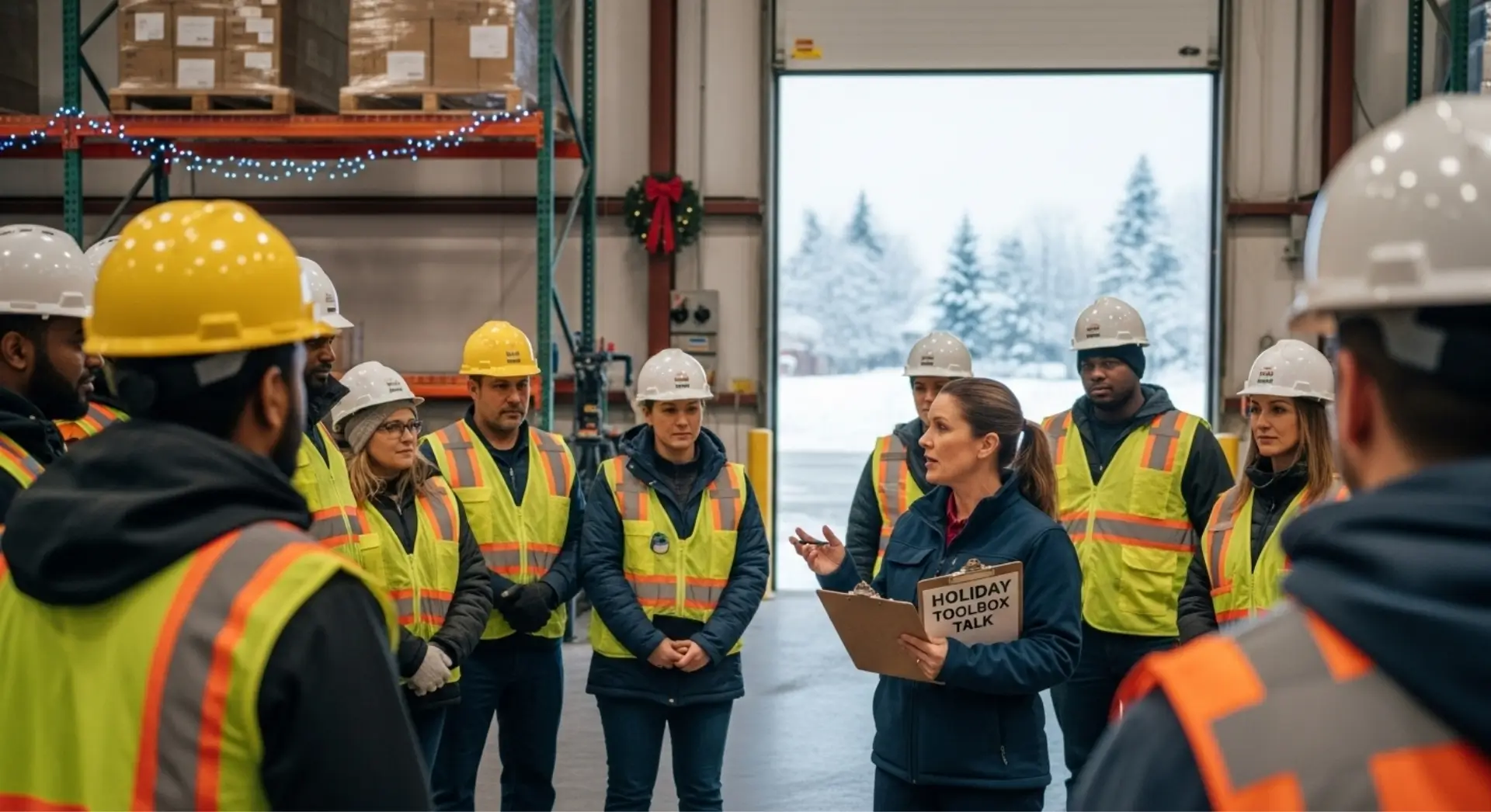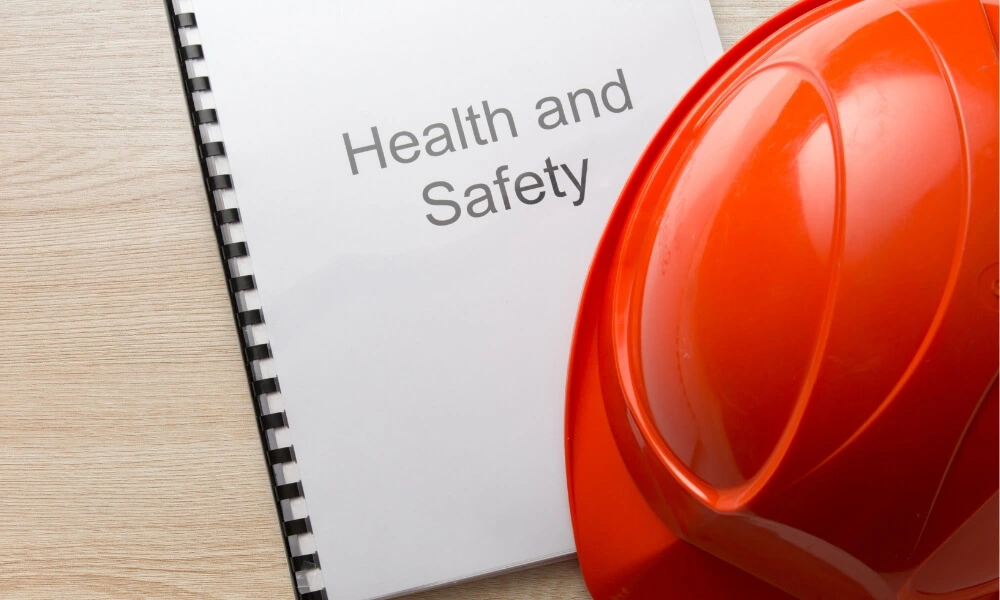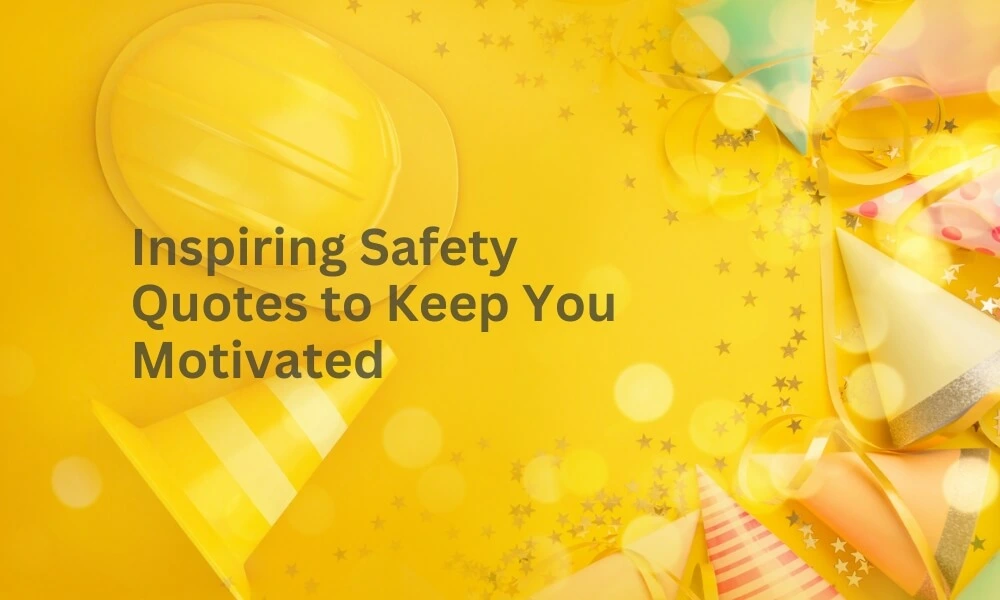Holiday Safety Toolbox Talks are short, focused safety meetings that help workers stay alert during one of the busiest – and riskiest – times of the year. As workloads increase, people rush to meet deadlines, weather conditions worsen, and decorations and celebrations multiply, the chance of accidents rises both at work and at home.
This detailed guide explains what Holiday Safety Toolbox Talks are, why they matter, how to run them effectively, and which topics to cover so your team stays safe all season long.
What Are Holiday Safety Toolbox Talks?
Holiday Safety Toolbox Talks are brief safety discussions held on the job, usually at the start of a shift or before a task. They focus specifically on hazards that become more common or more severe during the holiday period, such as:
- Winter weather and slippery surfaces
- Increased traffic and travel risks
- Fatigue from overtime, parties, or long trips
- Electrical and fire hazards from decorations and heaters
- Stress, distraction, and rushing to “get it all done”
The goal is to make workers stop, think, and act safely before they start their workday – and to remind them that safety matters just as much at home as it does on the job.
Why Holiday Safety Toolbox Talks Matter
During the festive season, several risk factors overlap: time pressure, staffing changes, seasonal work peaks, and personal distractions. Even your best workers can become less attentive.
Holiday Safety Toolbox Talks help you:
- Raise awareness of seasonal hazards that people might take for granted
- Reinforce company safety expectations during a hectic period
- Encourage employees to speak up about hazards they notice
- Extend safety thinking beyond the workplace into travel and home life
- Reduce the likelihood of incidents that can ruin someone’s holiday
By making these talks timely and relevant, you help your team make better choices in an unusually demanding time of year.
Core Principles of Effective Holiday Safety Toolbox Talks
Before diving into specific topics, it helps to understand what makes these talks effective. The best Holiday Safety Toolbox Talks usually share a few key characteristics:
- They are short and focused: Most last between 5 and 15 minutes and concentrate on a single theme. This keeps attention high and avoids overwhelming people with too many messages at once.
- They are practical and relevant: Each talk should relate directly to current conditions: icy parking lots, heavier customer traffic, added overtime, or upcoming company events.
- They are interactive, not lectures: Good talks invite questions, personal experiences, and suggestions. When workers participate, they remember more and feel more ownership.
- They end with clear actions: Every talk should answer, “What do we want people to do differently after this?” For example: walk more slowly on icy surfaces, inspect cords before plugging them in, or plan breaks during long drives.
- They are documented: Record the date, topic, and attendees. This shows your ongoing commitment to safety and helps you track which issues have been covered.
How to Structure a Holiday Safety Toolbox Talk
A simple structure makes it easier to prepare and deliver your talk, even on a busy day. You can use this five-step approach:
1. Set the Context
Begin with a brief introduction explaining why you’re holding a Holiday Safety Toolbox Talk today. Connect it to what people are experiencing right now. For example, mention the weather outside, the rush to meet end-of-year targets, or an upcoming holiday weekend.
This step should answer, “Why should I listen to this today?”
2. Describe the Specific Hazard
Clearly define the hazard you’re focusing on. Examples include:
- Slips and falls from wet, icy, or cluttered walkways
- Falls from ladders while hanging decorations
- Vehicle incidents during holiday travel
- Burn injuries from hot surfaces and cooking equipment
- Electrical fires from overloaded outlets
Explain how and where this hazard appears in your workplace or in everyday life during the holidays.
3. Explain the Possible Consequences
Help people understand what is at stake. Describe potential injuries, lost time, damage to equipment, and personal impact. You might reference a real incident (without blaming anyone) or a near miss that happened previously.
This is not about scaring people, but about making the risk feel real enough that they pay attention and care.
4. Present Practical Preventive Actions
Now move into solutions. List a small number of specific, realistic actions workers can take immediately. Stick to clear behaviours such as:
- Wiping up tracked-in snow or water as soon as it’s seen
- Using only inspected ladders rather than climbing on chairs or boxes
- Slowing down when walking or driving in winter conditions
- Taking scheduled breaks to avoid fatigue and rushing
- Checking extension cords, plugs, and outlets before using decorative lights
Keep the language simple and action-oriented so everyone knows exactly what “safe” looks like.
5. Involve the Group and Close
Invite team members to share their experiences: times they have seen someone slip, an overloaded outlet, a scary driving moment, or a near-miss while decorating. Ask them what they think would help prevent those incidents.
Finish by summarising the key point in one or two sentences, and ask everyone to commit to one specific action that day. Thank them for participating and remind them that staying safe now means they can fully enjoy the holidays with their families.
Key Holiday Safety Topics to Cover
You can run a series of Holiday Safety Toolbox Talks throughout the season, each one focusing on a different topic. Below are detailed topic ideas you can use or adapt for your workplace.
Decorations, Ladders, and Electrical Safety
Decorations make workplaces feel festive, but they introduce real hazards. People may climb onto desks or chairs to hang items, run extension cords across walkways, or overload power strips with lights and decorations.
A toolbox talk on this topic can cover:
- The proper use of ladders and step stools for decorating
- The importance of inspecting ladders for damage and stability
- The rule that chairs, boxes, and desks are never climbing equipment
- The need to route cords away from walkways and doorways
- The risk of overloading outlets and the importance of using rated power strips
- Turning off decorative lighting when areas are unattended
Emphasise that it only takes one fall or one electrical fault to cause serious injury or a fire, and that planning safe setups in advance is always worth the effort.
Winter Weather, Slips, Trips, and Falls
Snow, rain, and ice can turn simple tasks into serious hazards. Entrances become wet from boots, parking lots may be slippery, and visibility can be reduced.
A talk on this topic can discuss how weather affects walking surfaces, loading docks, stairs, and outdoor tasks. Encourage workers to slow down, use handrails, choose footwear with good grip, and watch for black ice. Explain the importance of placing mats at entrances, clearing walkways promptly, and reporting any unsafe surface so it can be treated or blocked off.
Driving and Travel Safety
Many workers travel more during the holidays, both for work and personal reasons. Roads are busier, weather may be worse, and fatigue is common.
In a driving safety toolbox talk, address pre-trip vehicle checks, including tires, lights, defrosters, and wipers. Emphasise leaving extra time, increasing following distance, and reducing speed during poor conditions. Discuss the risks of driving while tired or distracted, and encourage planning rest breaks during long drives.
Remind employees that safe driving protects not only themselves but also their passengers and everyone else on the road.
Fatigue, Stress, and Distraction
The holiday period can be mentally and emotionally demanding. Employees may be juggling overtime, family obligations, financial concerns, and social events. This often leads to tiredness, stress, and difficulty concentrating at work.
A toolbox talk on this theme can help workers recognise warning signs such as frequent yawning, difficulty focusing, irritability, and a tendency to rush. Encourage them to speak up if they are exhausted, to use break times properly, and to avoid shortcuts when they feel under pressure. Reinforce the idea that it is better to ask for help or adjust a schedule than to push through dangerously.
Fire Safety, Heating, and Cooking Hazards
Holiday meals, portable heaters, candles, and decorative lighting all increase fire risks. A fire safety toolbox talk can cover safe use of heaters (keeping them clear of combustible materials), safe candle placement, and the importance of never leaving open flames unattended.
If your workplace hosts holiday meals or potlucks, discuss safe use of kitchen appliances, keeping pathways clear in food areas, and proper handling of hot liquids and surfaces. Encourage checks of fire extinguishers, emergency exits, and smoke alarms at work and at home.
Warehouse, Retail, and Production Rush Hazards
In many industries, the holiday season is the busiest time of the year. Orders increase, stock levels change rapidly, and deadlines tighten. This can lead to more material handling, hurried forklift operations, and increased manual lifting.
A toolbox talk in these environments might focus on safe stacking of materials, respecting speed limits for forklifts, maintaining clear aisles, and using proper lifting techniques even when the workload is heavy. Emphasise that no shipment or sale is worth a serious injury.
Home and Off-the-Job Safety
Holiday Safety Toolbox Talks are a great opportunity to remind employees that safety does not stop at the facility gate. Encourage them to apply the same safety principles at home: safe decoration practices, careful use of heaters, checking smoke and carbon monoxide alarms, and planning safe travel for holiday visits.
When workers stay safe away from work, everyone benefits: fewer lost days, less stress, and more people returning after the holidays healthy and ready to work.
Example 10-Minute Holiday Safety Toolbox Talk
A 10-minute Holiday Safety Toolbox Talk is a short, focused safety meeting designed to deliver important information quickly and effectively. The example provided focuses on the topic of Slips, Trips, and Falls in Winter, one of the most common hazards during the holiday season. The following explanation breaks down each section of the talk to show what happens, why it matters, and how it supports worker safety.
1. Introduction (1–2 minutes)
This part sets the tone for the entire talk. The purpose is to get everyone’s attention and make the topic feel immediately relevant.
What happens in this section:
- The speaker acknowledges the current weather conditions (snow, rain, ice, freezing temperatures).
- They ask a relatable question such as, “Has anyone slipped on ice before?”
- This question prompts people to think about their own experiences and puts them mentally into the topic.
Why this matters:
- Personal connection increases engagement.
- Workers realize the hazard is real, common, and applicable to them.
- It creates a natural transition into the safety message.
2. Hazard Description (2 minutes)
This step explains exactly what the hazard is and how it shows up in the workplace during winter.
What happens in this section:
- The speaker describes how snow, ice, and rain create slick surfaces.
- They explain where these hazards appear: entrances, parking lots, hallways, stairs, loading docks, and entry mats.
- They mention how water gets tracked inside or frozen patches can form overnight.
Why this matters:
- Workers cannot avoid a hazard unless they understand where it occurs.
- Specifying locations helps workers visualize actual high-risk areas in their daily routine.
- Clarity makes prevention possible.
3. Consequences (2 minutes)
This section explains what can go wrong if the hazard isn’t controlled.
What happens in this section:
- The speaker talks about common injuries such as sprained ankles, fractures, bruises, and back injuries.
- They highlight how a slip can lead to unexpected time off, medical visits, or long recovery periods.
- They mention that incidents can ruin holiday plans and cause unnecessary stress.
Why this matters:
- Adults learn better when they understand the real-world consequences of their actions.
- When risks are clearly stated, workers are more likely to take safety steps seriously.
- Understanding impact creates motivation to change behaviour.
4. Preventive Actions (3–4 minutes)
This is the core of the toolbox talk. Here you explain what workers should do to avoid the hazard.
What happens in this section:
The speaker outlines practical steps, such as:
- Wearing proper footwear with traction
- Walking slowly and carefully
- Using handrails on stairs
- Reporting icy patches, wet floors, or missing mats
- Cleaning up water when they see it
- Giving more time for travel or movement around site
They also explain what the company is doing: salting walkways, laying down mats, clearing entrances, and maintaining lighting.
Why this matters:
- This is the actionable part of the talk where workers learn how to protect themselves.
- Clear instructions turn awareness into behaviour change.
- Explaining what the company is doing builds trust and shows shared responsibility.
5. Discussion and Close (1–2 minutes)
The final section ensures the message is understood and reinforced.
What happens in this section:
- The speaker invites workers to mention slip hazards they see regularly.
- Workers are asked what improvements could be made today.
- The speaker summarizes the key message: staying alert, slowing down, reporting issues.
- Everyone is thanked for participating and encouraged to remain safety-minded all shift.
Why this matters:
- Discussion builds engagement and gives workers a voice.
- Employees often notice hazards supervisors don’t see, so this helps improve workplace safety.
- Ending with a positive tone reinforces teamwork and responsibility.
A 10-minute Holiday Safety Toolbox Talk works because it is:
- Short – easy to deliver at the start of a shift
- Relevant – tied to real seasonal risks
- Interactive – encourages workers to participate
- Actionable – focuses on real steps people can take
- Effective – helps prevent common winter injuries
Each step has a purpose, and together they create a quick but powerful message that helps keep workers safe during one of the most hazardous times of the year.
Practical Tips for Supervisors and Safety Leaders
Supervisors and safety leaders play a crucial role in ensuring that Holiday Safety Toolbox Talks are effective and meaningful. The quality of the message, the way it is delivered, and the follow-through afterward all influence how well workers absorb and apply the information. The following practical tips help leaders conduct stronger talks and build a safer, more aware team during the busy holiday season.
1. Prepare a Simple, Clear Outline
Before delivering a toolbox talk, preparing a short outline is important. It keeps the message organized, reduces unnecessary talking, and helps you stay on the main topic. A good outline includes the title, the key hazard, the reason the topic matters, and the specific actions workers should take. Preparation shows professionalism and ensures that even a quick talk is structured and valuable.
2. Speak in a Practical, Relatable Way
Workers respond best when the information connects to their real experiences. Instead of speaking in general terms, use examples from the current environment, such as icy parking lots, crowded break rooms during holiday events, or increased delivery truck activity. The more the message applies to what workers see every day, the more likely they are to pay attention and follow your guidance.
3. Deliver the Talk with Confidence and Calmness
The way you speak affects how seriously workers take the message. Speak clearly, keep a steady pace, and maintain eye contact with your team. Avoid rushing, sounding unsure, or reading directly from notes the entire time. Confidence builds trust, and trust makes it easier for workers to accept safety instructions.
4. Use Real Incidents or Near Misses When Appropriate
Supervisors often have access to reports, observations, and firsthand experiences. Use appropriate, non-blaming examples to show how quickly accidents can happen. For example, mentioning a recent slip in the hallway or an electrical cord that was found stretched across a walkway helps workers understand that hazards are real, not theoretical. Examples also make the topic more memorable.
5. Encourage Worker Participation
A toolbox talk becomes more powerful when workers contribute. Ask questions, invite opinions, or request examples of hazards they have seen. When employees share what they notice, it helps reveal risks that may not be obvious to supervisors. Participation also increases engagement and helps workers feel respected and involved in safety decisions.
6. Reinforce One Clear Action
Every talk should end with one simple, direct action that workers can apply immediately. Examples include walking a little slower, inspecting a ladder before use, reporting icy patches, or turning off decorative lights before leaving an area. Giving too many instructions can confuse workers. Focusing on one key action ensures the message sticks.
7. Show Consistency Through Follow-Up
One of the most important things supervisors can do is follow up after the talk. If workers were asked to report hazards, check that reports are acted on quickly. If a walkway was identified as slippery, ensure it is treated or blocked off. When employees see real action taken after their input, they feel valued and become more likely to speak up in the future.
8. Provide Positive Acknowledgment
Recognizing safe behaviour encourages more of it. Simple acknowledgments such as saying “Great job placing mats at the entrance” or “Thank you for reporting the icy patch early” can significantly improve morale and safety engagement. Workers appreciate being noticed, especially during the stressful holiday season.
9. Keep Talks Short, Consistent, and Focused
Toolbox talks work best when they happen regularly and stay focused on one topic at a time. Consistency is more effective than long or complicated sessions. A well-delivered 10-minute talk every week creates stronger safety habits than sporadic long meetings. Regular sessions keep safety on everyone’s mind when seasonal risks are at their highest.
10. Lead by Example
Supervisors and safety leaders must model the behaviours they expect. If workers are told to walk carefully on icy surfaces, supervisors should demonstrate the same behaviour. If proper footwear is required, supervisors should wear it as well. Employees pay attention to what leaders do, and leading by example builds credibility and reinforces the safety culture.
These practical tips help supervisors and safety leaders turn toolbox talks into powerful tools for reducing seasonal risks. By preparing well, communicating clearly, involving workers, reinforcing key actions, following up consistently, and modelling safe behaviours, leaders can greatly improve the impact of Holiday Safety Toolbox Talks and protect their teams during the busiest and most hazardous time of the year.
Turning Holiday Safety into a Positive Tradition
Holiday Safety Toolbox Talks do more than prevent incidents. They send a strong message that the organization cares about its people as whole human beings, not just as workers. By discussing both on-the-job and off-the-job risks, you show genuine concern for their families, well-being, and ability to enjoy the festive season.
Over time, these seasonal talks can become a positive tradition. People will come to expect them, contribute their own stories, and take pride in helping everyone get through the holidays safely.






